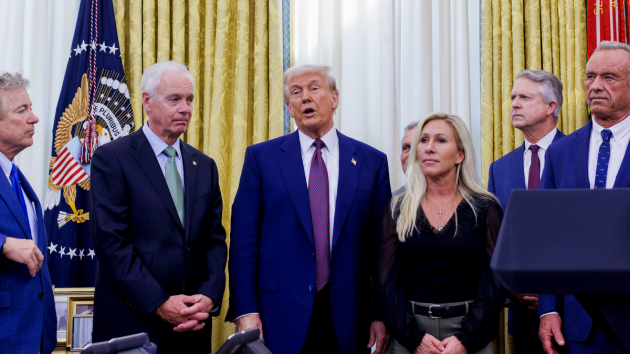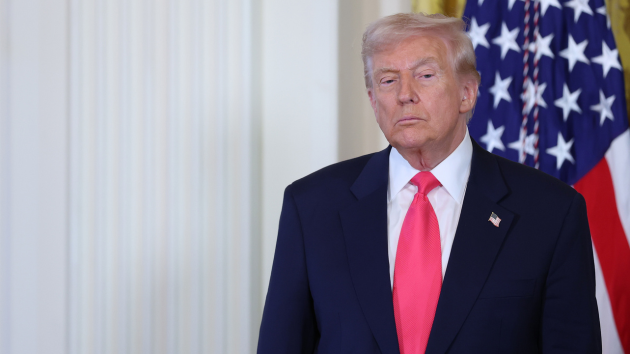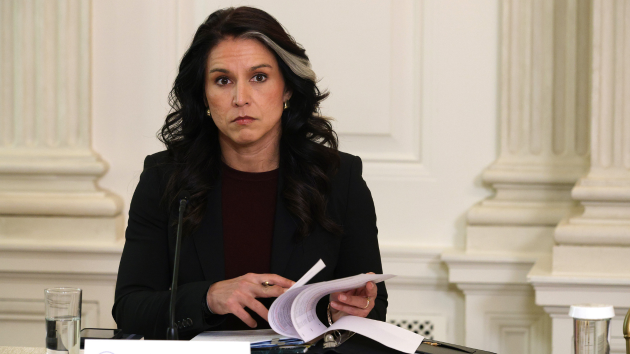Trump and the ‘unitary executive’: The presidential power theory driving his 2nd term
Written by ABC Audio ALL RIGHTS RESERVED on February 7, 2025

(WASHINGTON) — As President Donald Trump works at a breakneck speed to implement his second-term agenda , including wholesale firings and sweeping policy changes, he and his advisers assert his power over the executive branch is complete and can’t be questioned.
Still, his flurry of executive actions and orders spark a critical question: Does he have the power he claims to have?
Multiple court challenges are underway trying to stop his attempts to end birthright citizenship and temporarily freeze federal loans and grants.
More legal pushback will unfold amid Trump’s unprecedented purge of the executive workforce and reshaping of what Congress set up as independent agencies, the dismantling of which is largely being carried out by Elon Musk’s Department of Government Efficiency.
Trump quickly fired 17 independent watchdogs and the director of the Consumer Financial Protection Bureau. Longtime Democratic Federal Election Commissioner Ellen Weintraub said Trump sent a letter removing her from the commission. His administration has directed all federal DEI staff be put on leave. The Justice Department fired more than a dozen of prosecutors who worked on Jan. 6 cases. Millions of employees were offered buyouts, with tens of thousands of people accepting them.
His administration has touted the moves as long-overdue cutting of waste in favor of a merit-based system. His critics slam them as a radical restructuring of the federal government aimed at consolidating presidential power — and placing loyalty to Trump over regulatory agency expertise designed to be insulated from political influence.
The ‘unitary executive theory’
Driving Trump’s strategy is a legal framework championed by conservatives, perhaps most notably by Trump’s newly-confirmed director of White House Office of Management and Budget, Russell Vought, an architect of Project 2025. (Democrats held an all-night protest of Vought’s nomination on the Senate floor Wednesday into Thursday, though his nomination was later approved by Republicans.)
The so-called “unitary executive theory” has various iterations but centers on the idea that the Constitution gives the president sole control over the executive branch of government.
Its advocates point to Article II, which reads in part: “The executive Power shall be vested in a President of the United States of America.”
“I think that means he has the power to control subordinates throughout the executive branch, including in the independent agencies and how they exercise power. And as a corollary to that, he has the power to remove or fire subordinates in the executive branch,” said Steven Calabresi, a Northwestern University law professor and former Reagan administration official who co-authored a book on the unitary executive theory.
Trump in 2019 said: “I have an Article II, where I have the right to do whatever I want as president.”
Setting up Supreme Court test cases?
Some of Trump’s firings, especially those that seem to fly in the face of statutory protections for civil service workers from being removed without cause, are likely to result in lawsuits that put that theory in front of the courts.
“I think they are setting up test cases, and this Supreme Court is very likely to expand the theory and overrule other cases that are in tension with it,” said David Driesen, a law professor at Syracuse University.
In 2020, the Supreme Court found a provision from Congress limiting the president’s authority to remove the director of the Consumer Financial Protection Bureau violated the Constitution — a departure from precedent. The Trump White House has pointed to that ruling as justification for some of its firings.
Trump pushing limits on executive authority
But some say Trump is leaning on the theory to go even further, blatantly trying to take over powers the Constitution gives to other branches of government, namely Congress, violating the separation of powers and the concept of checks and balances.
“This is where the debate is: at what point does the kind of power that Trump wants and the way he exercises his power cross over from a constitutional vision about presidential power to an a-constitutional vision,” said Bob Bauer, a law professor at New York University and former White House counsel under President Barack Obama.
“The unitary executive theory has a history that isn’t nearly, in my judgment, what is claimed for it and now put into effect by Trump and his allies,” Bauer added.
Trump has sought to sidestep Congress and take control of federal spending, trying to freeze money already appropriated by lawmakers. His OMB pick, Vought, told senators during his confirmation hearing that the Trump administration would seek to impound funds it believes are being misspent.
Even bolder, Trump’s pledging to dismantle entire agencies. Turmoil is roiling USAID as its being taken over by the State Department and its staff reduced from 14,000 people to fewer than 300 staff, sources said. Trump is expected to move soon on his proposal to cripple the Department of Education just short of eliminating it.
Many of this will play out in the courts in the months ahead. But experts said, in the meantime, harm will be immediate and possibly felt for years to come.
“He’s going to do an enormous amount of damage that the courts can’t in all cases readily remediate,” Bauer said. “By the time he’s finished emptying out some of these agencies and in some cases closing them, putting all that back together again is going to be very challenging.”
“It will take years to rebuild some of these institutions. So, Trump and his team will accomplish much of what they want before the courts can fully and effectively respond. He will have created new facts on the ground.”
Copyright © 2025, ABC Audio. All rights reserved.





